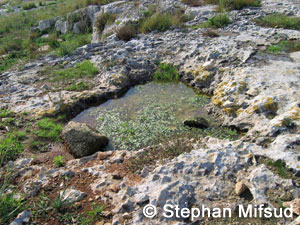
[Note: This is an expanded version of an article that appears in TAG v.17, No. 4.]
09-13-2006, Web-Exclusive pdf: A Comparative Study between Elatine gussonei (from Malta) and Elatine macropoda (from Majorca)
On a sunny winter day, some 25 winters ago, a boy was hiking along a rugged
path through rocky Mediterranean high-ground known as garigue. This was a windswept
tree-less landscape dotted with drought resistant shrubs so it came as a surprise
when he heard a splash just ahead. Water, here?
Hurrying towards the sound, he came to a rainwater rock pool, some 5 ft. wide and a few inches deep. The surface was still rippling from the emergency dive of a Painted frog, which was now attempting to hide among the aquatic plants. This was another pleasant surprise. The boy had not expected water, let alone the various aquatic plants he saw here. One in particular was eye-catching: a small, almost mossy plant that carpeted the pool in bright green. Crouching down, the boy saw that the pool was animated by tadpoles, miniature diving beetles, elegant fairy shrimps and a host of smaller creatures. Fascinating!

That was the first time I was enthralled by this freshwater pool life. Later it became a hobby to find similar rock pools scattered 'round the islands of Malta and Gozo. Even now, many years later, I am still discovering new aspects in the nature of these miniature water-worlds.
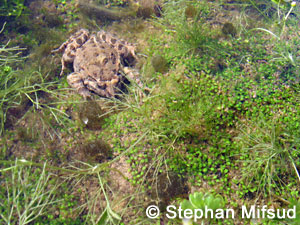
Vernal
(winter) pools are found in other Mediterranean
climate zones including those in parts of California, Australia, Chile and South
Africa. They are only kept full during the rainy winter season and remain dry
throughout the summer. Here in Malta most temporary pools form in shallow depressions
in karstified limestone. These hollows were originally formed by the action
of CO2-acidified rainwater dissolving away the limestone substrate
over many years.
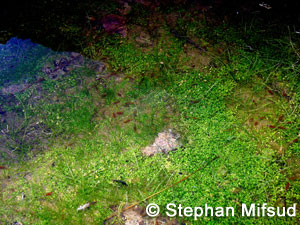
The pools that form in them today are a few feet wide at most, so their inhabitants are proportionally small. These residents are highly specialized to this temporary aquatic habitat. They must grow and reproduce in the short wet season and then somehow survive the hot dry summer months. The plants do this in the form of seeds or dormant bulbs, crustaceans in the form of resistant eggs, while insects and amphibians turn into their terrestrial forms and move elsewhere. Many types of creatures inhabit these pools, yet there are no fish or mollusks that have adapted to this isolated and ephemeral habitat.
Considering their small size, the pools have a surprisingly varied flora. Some terrestrial plants can grow in marshy conditions. Others are more aquatic in nature and are restricted to these pools and nowhere else. Callitriche truncata (with whorls of transparent leaves) and Zannichellia melitensis (an endemic pondweed like plant) are both completely submersed aquatics that also flower and fruit underwater. The water-crowfoot Ranunculus saniculaefolius and the Echinodorus-related Damasonium bourgaei each have submersed and emergent leaf types. Mentha pulegium (Pennyroyal) and the red-stemmed Lythrum hyssopifolia are amphibious Ludwigia-type plants. The succulent Crassula vaillantii and the Arrow grass Triglochin laxiflorum are both well adapted to the shallowest of pools, which dry up repeatedly between the rains. Few algae are attractive but Chara can sometimes form interesting carpets. Even so, the best-looking carpeting plant is surely Elatine gussonei, the small plant that caught my eye many years ago.
.jpg)
Elatine gussonei looks much like Glossostigma elatinoides (note the latter’s specific epithet) but is much smaller, with leaves less than 1/10th the area of the full-sized Glossostigma.
In nature Elatine grows submerged, its creeping stem grows through the pool’s mud, branches frequently and regularly sends up paired spoon shaped leaves. Many plants intertwine so that in good conditions a thick carpet can cover the pool’s bottom. The leaves grow up and curl out. The wide ends are horizontal, so that from above they look rounded.
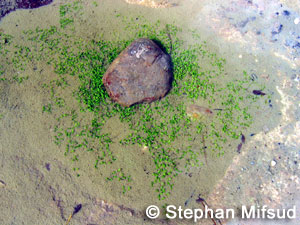
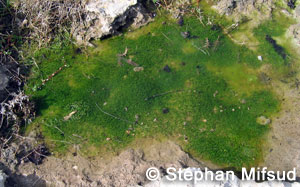
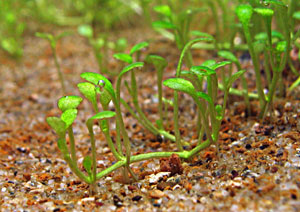
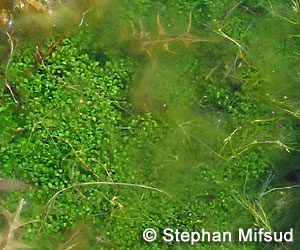
Although a sun lover, it can tolerate some shade since it often has to grow below mats of other plants or algae. Toward the end of the rainy period it starts producing many round flower buds, which grow up on stalks to meet the rapidly dwindling surface. There they burst into tiny pink flowers that are pollinated by small flies and ants.
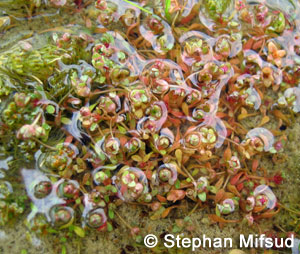
In intense sunlight the color of the whole plant turns reddish. This does not last long because after a few days the pools are bone dry. The plants wither and the miniature fruits crack open releasing a number of small hook-shaped seeds. Many are carried off by ants, which may unwittingly act as dispersal agents of the plant, much like squirrels do with acorns.
During the dry summer months the seeds ripen slowly so that half a year later they are able to germinate in synchrony with the arrival of the autumn rains. This mechanism probably serves to avoid germination following freak rain showers in the summer months. If that happened any unfortunate seedling would be doomed before it could reach flowering size.
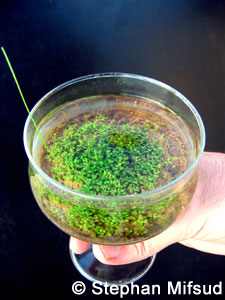
Elatine gussonei is listed as a rare species, so I consider collection from the wild unethical. It is also unnecessary, since the plant multiplies rapidly in captivity and produces large quantities of viable seed. So starting from a few seeds some years ago I have been increasing the number of shallow containers in which I grow this plant. I keep them on my roof so they fill up naturally with rain and are dry during the summer just like in nature. It has become a seasonal hobby watching these miniature gardens come to life every autumn, grow and later flower without any help from me.
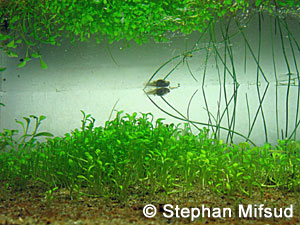
Last year I wondered if I could extend the life time of the plant by growing it indoors, especially since I had found out that other species of Elatine had been successfully used as aquarium plants (discussed later). So I tried growing the little Elatine in my living room display tank, but lighting levels were too low and the size of the gravel too large for it.
This year I set up a mini aquarium (11-inch wide) with a soil-sand substrate, yeast CO2, and a 12-Watt desk light. Summer-ripened seeds from my roof pools germinated in a couple of weeks and after another 8 weeks started to carpet the sand. I aquascaped the mini-tank with a few rocks inspired by a Maltese landscape and watched the Elatine fill in with a lush green.
Then bewilderingly the Elatine started to turn yellow, stopped growing and started to die. Despairingly I added calcium nitrate, and increased the potassium and traces, but the situation grew worse. I was still experimenting so I did something controversial; I added phosphate (as KH2PO4)! The improvement was miraculous; in a few days the plants looked better than ever. Yet why did the Maltese Elatine grow so well in natural rainwater pools (and my roof pools) so deprived of major nutrients? Whatever the reason, I learned my lesson—not to use natural conditions as the model for plants in aquaria.
In nature E. gussonei is an annual; i.e. flowering triggers a countdown to death. I wanted to avoid flower initiation if the plant was to survive for long in the aquarium. Outdoors, I had observed that flower buds were initiated by three natural conditions: an increasing day-length and an increased sunlight intensity (both signifying the approaching end of the winter-wet season) or by exposure to air (which meant that the pool had dried and the plant needed to flower quickly before it died). To keep the plant alive I had to avoid these three conditions. This was relatively easy. All I had to do was make sure that the aquarium did not receive any sunlight and did not dry out. While outside all the plants perished as the pools dried, those in my aquarium were growing merrily.
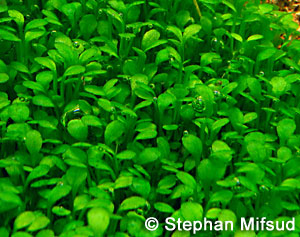
Soon the entire substrate was covered in a green carpet, which became so compact that in one place it started to produce a fold that gradually pulled out the roots from the substrate. This was actually threatening to detach the entire carpet so with a tailor’s touch I cut out the plants along the crease with a scissors, pinched the two sides of the tear together and placed a glass tumbler on top. After a week the plants across the cut entwined and “stitched” the tear so I could remove the glass. A self-repairing carpet!
My biggest worry at that point was the approaching summer temperature, which can top 33°C in uncooled aquariums. I know that E. gussonei grows easily at 20 - 25°C but above 28°C it starts to decline. During the summer I placed a small fan over the surface and kept the temperature of the water below 28°C. The plants continued to grow. Without flowering their annual nature has been bypassed, so they may be the longest lived members of their species ever.
So could Elatine gussonei become a popular aquatic plant? Probably not. Like most other Elatine species it has such a limited nutrient reserve that it quickly dies without light, making transport of adult plants very difficult. Seeds would not fetch a good price so I guess that like its relatives it is not commercially viable. Also, with Glossostigma now confirmed an established foreground favorite there seems to be little need for any of the similar-looking Elatine species. Even so, it has been a great satisfaction to grow this little beauty in a local biotype tank while comparing and contrasting its natural environment to my artificial setup.
The genus Elatine contains around 12 species scattered throughout the world. In 1977 Rataj i mentioned 4 species, of which E. hydropiper and E. macropoda were considered good aquarium plants. The best of these two was considered to be E. macropoda, also from the Mediterranean region (a plant with which E. gussonei was previously confused—see Taxonomic Note). In 1987 E. macropoda was again described and illustrated as a “beautiful” aquarium plant in “Holger Windelov’s Tropica Color Catalogue.” ii In the 1990s, E. gratioloides from New Zealand was also found to be suitable in the aquarium.iii Yet even with all of this publicity, none of these Elatine became popular aquarium plants and now appear to be cultivated only very rarely.
On the other hand, Elatine triandra*, which was dismissed as a good aquarium plant by Rataj, has very recently been widely used as a beautiful foreground plant in Singapore (locally referred to as APP i.e. Ah Pek’s Plant). It is now catching up in other parts of the world. While E. triandra is cosmopolitan, the cultivated variety quite possibly originated from Asia, where it also grows as a weed in rice paddies. E. triandra looks rather like a miniature sprawling Hygrophila polysperma so it has little resemblance to its much smaller relatives, E. macropoda and E. gussonei.
*I have confirmed the ID of this plant from its flowers and seed, which I have also been able to germinate.
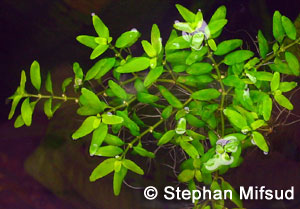
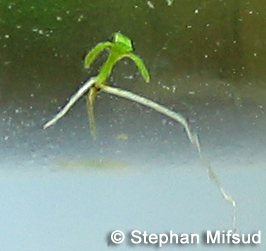
1) Many plants start bud formation in January when day-lengths begin to increase.
2) In shaded/deeper pools, where the plants do not receive the same intensity of light, budding starts much later, in February and even March.
3) If there is an extended dry period such that pools dry up for more than a couple of days, affected plants will flower even if it is still October.
For a long time, this plant—full name Elatine gussonei (Sommier) Brullo, Lanfranco, Pavone & Ronsisvalle—was considered to be just a variety of Elatine hydropiper L., and confused with the widespread Mediterranean species E. macropoda Gussone. But in 1988 the Maltese Elatine was elevated to species status because of its different flowers and seeds. (E. macropoda has white, shorter petalled flowers and less curved seeds. In E. hydropiper flowers are not stalked i.e. sessile.) E. gussonei is restricted to the Maltese islands and neighboring Lampedusa. It was named after Gussone, the Italian botanist who first described E. macropoda in the 19th century. 09-13-2006, Web-Exclusive: A Comparative Study between Elatine gussonei (from Malta) and Elatine macropoda (from Majorca)
water pepper
09-13-2006, Web-Exclusive: A Comparative Study between Elatine gussonei (from Malta) and Elatine macropoda (from Majorca)